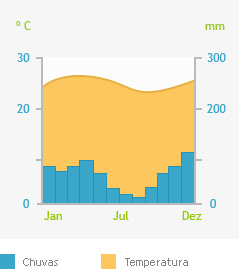Approximately 8 kilometers long and with a population of 20,000, the peninsula of Búzios is bathed by the Antarctic and Brazilian ocean currents. To the north, the resort town offers calm beaches and slightly warmer water like in Tartaruga, Azeda, and João Fernandes beaches. To the south, the beaches are usually bathed by the open sea and cold water – as is the case with Geribá and Tucuns and also of some coves like Ferradura and Forno. With a rather peculiar geography, Búzios seems more like an island.
 Aerial view of the city
Aerial view of the city
The wind that blows from the east and Búzios’ peculiar microclimate keep the rain away and maintain a pleasant temperature that averages 26 º C annually. Compared to other destinations in the state of Rio, the average of sunny days and starry nights in Búzios is about twice as high as in Rio de Janeiro and three times higher than in Angra dos Reis.
For those who are not interested in the hubbub, the best time to visit the city is outside the high season and long weekends, between March and November. Not to mention that, during this period, the rates in hotels and inns are quite inviting.


